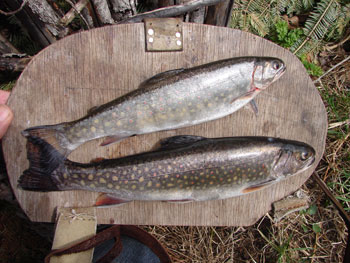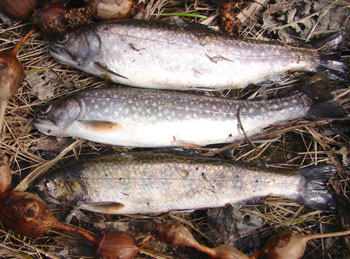When Trout Go To Sea
by Tom Seymour

The overall appearance is rather silvery and iridescent. A brook trout newly arrived from sea has a bright sheen. The blue halos around their red spots are present. The effect here is something like looking at a holographic image. Tom Seymour photo
Everyone has heard of herring runs, smelt runs and alewife runs. But with the exception of those living in coastal regions, few are aware of trout runs.
When fish spend portions of their lives in both fresh water and salt water, they are said to have become “anadromous.” In any given population of trout, a certain percentage of that population will be predisposed to go to sea for a time. Others, prefer to remain in their natal stream for their entire lives. The reason for this disparity is not fully understood. But then again, the anadromous, or sea-run, trout population ranks among the least-studied group of salmonids of all.
Of all the trout species in Maine, brook trout, Salvelinus fontinalis, are most likely to go to sea. Other less-numerous species also become anadromous when given the opportunity. The author has taken both rainbow trout and brown trout in coastal streams where they were not known to be present. In both instances, a call to the Maine Department of Inland Fisheries and Wildlife disclosed that the trout in question were released into inland lakes many months prior, had escaped downstream and were finally caught many miles from the point of release.
Mysterious Habits
Sea-run trout lead lives shrouded in mystery and that raises many questions. How long do these fish stay at sea? What do they feed upon when at sea? When do they leave their freshwater environments to go to sea, and do all fish migrate at the same time, or is migration more fragmented?
While many of these questions remain unanswered, enough anecdotal information exists to at least give an overall picture of seagoing trout. While it remains unclear whether or not all trout in any particular stream migrate downstream at the same time, it is patently clear that returning fish do not do so en masse. Rather, it appears that small groups, beginning in early spring, return in fits and starts.
Trout undergo various physiological changes
upon entering saltwater.
For instance, a large pool on a trout stream may hold good numbers of recently returned fish today and by tomorrow, these trout will have already traveled far upstream. But in a day or two another batch of returning fish, bright from the sea, will take temporary residence in that same pool.
Interestingly, trout don’t necessarily need to spend time at sea to be considered anadromous. For instance, streams that feed into the Penobscot River host runs of sea-run trout. These fish may have never gone downstream far enough to reach the sea and instead, might have simply spent a season or more in the river. On the other hand it is entirely possible that trout from far inland, once reaching the Penobscot River, make the trip to the sea.
It doesn’t take long for trout to travel great distances. A determined group of trout from some small stream 30 miles inland and more, could probably reach the sea in two or three days.
Physical Changes
Trout undergo various physiological changes upon entering saltwater regions. Bodies get thick and muscular, due to dietary changes and possibly as a result of fighting tidal currents. And heads, by comparison, appear somewhat small for the bodies.
Something else happens, too. Fish become iridescent. The overall appearance is rather silvery, but hold a trout in hand and turn it one way and another and it appears to iridesce. The effect here is something like looking at a holographic image. Turn the image and the light pattern changes.
A brook trout newly arrived from sea has a bright sheen. And while the blue halos around their red spots are present, they require some effort to discern. Likewise for the wormlike vermiculations on the back. They too are present, but barely detectable.
Here’s another feature of brook trout fresh from the sea. They jump and cartwheel when hooked. As a rule, brook trout do not jump when hooked, preferring to bore down toward bottom and slug it out there. But not so with anadromous trout.
This habit soon disappears after trout become re-acclimated to freshwater conditions. Also, their silvery iridescence quickly fades and in only a few weeks after their return, sea-run trout bear little or no resemblance to their still-at-sea companions.
Seasonal Streams
Maine holds numerous small streams that see springtime runs of anadromous brook trout. Many of these streams become very to low to support trout soon after springtime snowmelt ends. When that happens, trout either find their way upstream to cool, spring-fed holes or else they return to the sea. But even in summer, trout will return to these seasonal streams after heavy rains once again raise water levels to comfortable heights.
Maine will remain
the last best place
to find anadromous
brook trout.
Most of these little streams are small enough for a person to jump from one side to the other and not suffer wet feet. Still, at one time or another, sea-run trout will enter during periods of high water.
Essentially, any stream or river that leads to the saltwater stands as a possible host to runs of anadromous brook trout. The runs don’t always extend very far upstream and in the case of brooks and streams that cross coastal highway U.S. Route 1, most sea-run trout are taken on the ocean side of the highway.
Sometimes returning trout remain in the first upstream pool or two and won’t venture further upstream. In fact, anadromous trout sometimes, before even entering a stream, will hold off the mouth of the stream for an extended period. At this time it is possible to catch trout in tidewater. One trick that fishermen use is to wait for low tide and then, keeping a low profile in order not to frighten the fish, sneak up to within casting distance of tidal pools and take trout trapped there.
This practice circumvents the April 1 official beginning of open-water fishing in brooks and streams, since saltwater fish are regulated differently and trout are fair game any time they are in saltwater environs.
Earliest Fishing
While anglers further inland have little chance of catching trout until sometime later in April or even early May, coastal anglers sit in the driver’s seat on the first of April. In fact, the first few days of the season are often the most productive on the coastal streams with runs of anadromous trout.
Interestingly, a connection between size of stream and size of trout exists. Large streams and small rivers host the largest trout, some of which run between 14 and 16 inches. The tiny streams mentioned earlier usually hold mostly 6- to 7-inch fish.
Also, it appears, at least in the author’s rather extensive experience, that smaller trout move into freshwater regions ahead of larger fish. This isn’t 100 percent carved in stone, but as a general rule it has withstood the test of time.
People who fish for anadromous trout on a regular basis are well aware of average arrival times for the streams they fish. In fact, dedicated sea-run trout anglers are usually able to plot the migrations, detailing how far upstream returning trout should have reached by a certain date.
One of the author’s regular haunts, a small stream where it is possible to take returning trout within sound of the sea, begins in early April with limited runs of trout. But by the time of school vacation, some time around the third week of April, larger groups of trout ascend the stream. It is possible to note arrival dates on a map and have those dates correspond amazingly close to the actual arrival dates.
 Trout Myths
Trout Myths

In years past, people had some odd ideas regarding what anadromous trout really were. Some folks referred to them as “silver trout,” a totally inaccurate name. Silver trout, Salvelinus fontinalis agassizi, which occurred naturally only in Dublin Pond, NH, are a separate strain of brook trout. Silver trout in Dublin Pond are now extinct.
And then some people believed that anadromous trout were a separate species. This misunderstanding is at least somewhat reasonable, given the will-o’-the-wisp nature of returning sea-run brook trout.
On some streams, notably those that hosted runs of Atlantic salmon, sea-run trout and salmon smolts were thought to be the same species, which of course was not the case at all.
Angling Tips
Brook trout as a rule are fairly unsophisticated and are more easily caught than their relatives, brown and rainbow trout. Sea-run brook trout share that same lack of sophistication. Most sea-run brook trout are taken on angleworms, an age-old bait for trout.
But anadromous trout also willingly strike a variety of lures. Bright colors attract hungry trout and any fly or small lure with red, yellow, orange or a combination of any of these colors will take trout.
The author now uses small lures called “Trout Magnets” for most of his trout fishing. On some of the larger streams, though, where it is possible to cast a fly, a bucktail called “Edson Tiger Light” never fails to elicit a strike, as long as trout are in the stream.
As the years go by, trout runs have diminished in some coastal streams. Deforestation of the riparian habitat due to housing construction has ruined forever strains of trout that lived in these small streams since well before recorded history. Many of the fish in these tiny watersheds are genetically different from trout in other places, making them a precious resource.
Also, streams and small rivers that see dozens of elver nets in spring have seen a decrease in returning brook trout in recent years. While excluders on the nets keep trout from actually entering, just the presence of obstructions appears to have a negative affect upon trout runs. However, this, too, ranks as strictly anecdotal evidence and cannot be proved.
But no matter what happens, Maine will remain the last best place to find anadromous brook trout. Other northeastern states, notably Rhode Island and Massachusetts, see trout runs, but these in no way reach the volume or numbers seen on Maine’s coastal streams.
Anadromous trout are a precious resource and Maine remains the undisputed capital of sea-run brook trout.
People who like fishing but have never taken a sea-run trout should give it a try this year, if for no other reason than seeing and catching one of these shining beauties for the first time.
